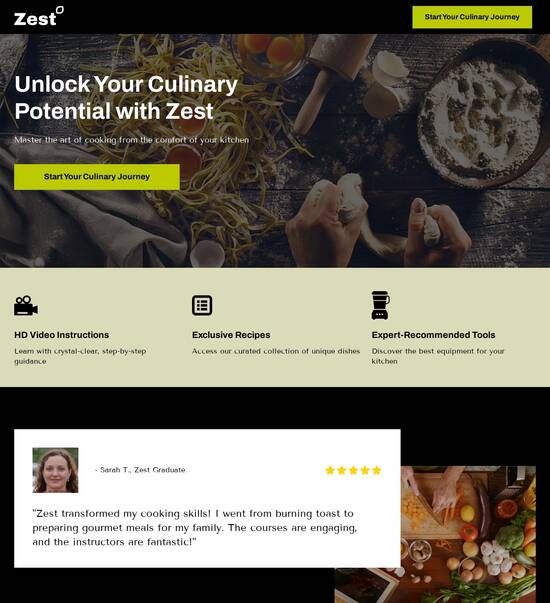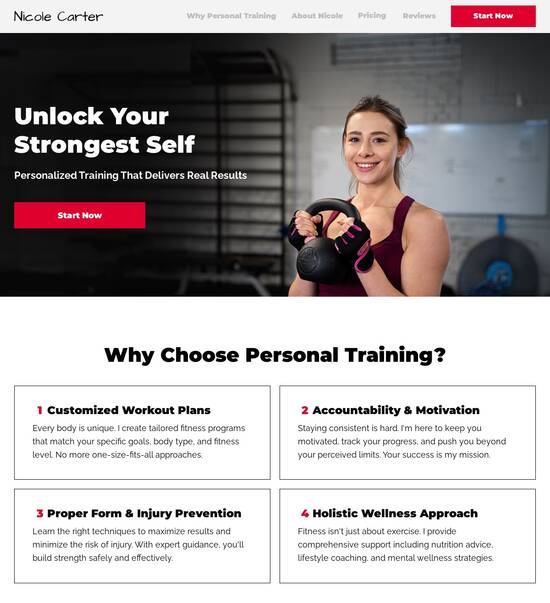
Wiki website template
Explore Similar TemplatesAbout template
Our wiki website template is built with lead conversion in mind. Take the full advantage of your marketing campaigns with Instapage.
Recommended templates

Easy to build without coding
With the intuitive drag-and-drop builder, anyone on your team can create high-converting pages without any knowledge of code or design. Make enhancements to your landing page with custom widgets using Javascript, HTML/CSS, or third-party scripts.

Multiple layouts for any industry and goal
Select from 500+ landing page layouts built to boost conversions across industry-specific scenarios. Customize them by adjusting fonts, adding images, and generating on-brand content with the AI assistant. Quickly scale with Instablocks® and Global Blocks that you can save, reuse, and update globally.

Loads fast and looks polished on any device
Every template is responsive, which means they present professionally on any device and load blazingly fast with our Thor Render Engine. You can also power them up with Google AMP technology to deliver an unparalleled mobile experience and drive higher conversions.

Robust analytics & experimentation
Get real-time updates and reporting across all your devices, showing the number of visitors, conversions, cost-per-visitor, and cost-per-lead. Launch AI-powered experiments, run A/B tests, and use heatmaps to analyze user behavior, then optimize your landing page to maximize conversions.







Easy to build without coding
With the intuitive drag-and-drop builder, anyone on your team can create high-converting pages without any knowledge of code or design. Make enhancements to your landing page with custom widgets using Javascript, HTML/CSS, or third-party scripts.
Multiple layouts for any industry and goal
Select from 500+ landing page layouts built to boost conversions across industry-specific scenarios. Customize them by adjusting fonts, adding images, and generating on-brand content with the AI assistant. Quickly scale with Instablocks® and Global Blocks that you can save, reuse, and update globally.
Loads fast and looks polished on any device
Every template is responsive, which means they present professionally on any device and load blazingly fast with our Thor Render Engine.
Robust analytics & experimentation
Get real-time updates and reporting across all your devices, showing the number of visitors, conversions, cost-per-visitor, and cost-per-lead. Launch AI-powered experiments, run A/B tests, and use heatmaps to analyze user behavior, then optimize your landing page to maximize conversions.
All the features you need to build wiki page template
Explore more featuresLearn how to build wiki website template
Frequently asked questions about wiki website templates
Leading the way in building high-performing landing pages





Wiki page templates: Your ultimate how-to guide
When it comes to maximizing the efficiency of your digital marketing campaigns, understanding the power of Instapage's landing page solutions is crucial. As the leading platform for creating tailored landing pages, Instapage equips marketers with tools that not only streamline the creative process but also amplify the return on investment. With its wide array of templates and optimization features, Instapage is set to revolutionize how businesses connect with their audiences in a crowded digital landscape.
Understanding the fundamentals of landing page creation
The first step in utilizing Instapage effectively is understanding how to leverage its rich template library and user-friendly builder. This platform eliminates the need for complex coding, allowing marketers from various industries, whether in business services or tech, to design stunning landing pages that align perfectly with campaign goals.
- Choose from over 100 conversion-driven templates that are customizable to fit your brand's unique identity.
- Utilize pre-built lead generation elements to enhance user engagement from the moment they land on your page.
- Implement dynamic text replacement to tailor the content for different audience segments effectively.
Optimizing landing pages for higher conversions
Once your landing pages are created, the next crucial step is optimization. Instapage’s built-in experimentation features offer valuable insights into user interactions, enabling marketers to fine-tune their pages for better results.
- Conduct A/B tests to determine which elements perform better, from headlines to call-to-action buttons.
- Monitor detailed heatmaps that showcase user on-page behavior, guiding further optimization.
- Leverage the analytics dashboard to assess real-time performance and adjust strategies immediately.
Personalizing user experiences for targeted marketing
To improve campaign effectiveness, personalizing user experiences is essential. Instapage's advanced personalization capabilities allow marketers to dynamically adjust content based on user data, ensuring relevance and engagement.
- Use AdMaps to align specific ads with dedicated landing pages, enhancing the coherence of your campaigns.
- Track metrics at the audience level to analyze how different segments interact with your pages.
- Create personalized experiences with targeted content views to ensure your audience feels uniquely addressed.
These steps, when implemented correctly, can dramatically enhance conversion rates and overall campaign performance. Instapage stands out as a comprehensive solution that simplifies every phase of landing page creation and optimization.
In conclusion, leveraging Instapage effectively involves understanding its myriad functionalities and applying best practices for maximum ROI.
Ready to take your digital marketing campaigns to the next level? Start creating high-converting landing pages today with Instapage and watch your conversion rates soar.
The essence of wiki website templates: A guiding framework for every creator
Understanding wiki website templates
At its core, a wiki is a collaborative platform where users can create, edit, and organize content collectively. This digital tool has gained momentum since its inception in the late 1990s, evolving from simple text-editing systems to sophisticated knowledge databases. The original vision set by pioneers like Ward Cunningham with the WikiWikiWeb has flourished into various platforms like Wikipedia, which houses millions of articles contributed by users worldwide. Today, wikis serve as vital resources for information sharing across different sectors, including education, business, and community engagement.
The creation of a wiki typically requires a well-structured layout, which is where wiki website templates come into play. These templates provide a pre-defined framework that minimizes the complexities of design and allows creators to focus on content rather than aesthetics. By utilizing a wiki website template, individuals can ensure consistent formatting, seamless navigation, and adherence to best practices, allowing for a more efficient workflow and an enhanced user experience.
The innovative features of wiki website templates
One of the standout characteristics of wiki website templates is their user-friendly design interface. Typically built on minimalistic design principles, these templates promote easy navigation and content accessibility. A streamlined layout minimizes distractions, enabling users to engage with the information presented without unnecessary clutter. Furthermore, many wiki templates offer multiple layout variations that cater to different content types, ensuring a customized fit for diverse project needs.
Beyond aesthetics, customizability and flexibility stand at the forefront of wiki website templates. Creators can modify various design elements, such as color schemes, fonts, and structural components, to align with their branding or functional needs. For instance, some templates might support interactive features, such as embedded multimedia or forms, which can enhance user engagement. The adaptability allows every creator to forge a unique identity for their wiki while adhering to a tested design framework.
Additionally, responsive design capabilities enable these templates to cater to a mobile-first audience. With countless users accessing web content via smartphones and tablets, ensuring that a wiki template performs seamlessly across devices is vital. A modern wiki template guarantees that users benefit from a fully optimized experience, adapting gracefully to different screen sizes while maintaining performance and accessibility.
Essential components of a comprehensive wiki template
To create an effective wiki website, certain key sections should be incorporated into the template. Typical elements include: a Home page for an overview of the content, an About section detailing the wiki's purpose and contributors, a FAQ area to address common inquiries, and individual pages for different topics or projects. Prioritizing these sections not only assists in delivering clear information but also enhances user navigation. A logical layout encourages visitors to browse, learn, and engage with the content more intuitively.
Home - A central page providing core information and links to important content.
About - Background and purpose of the wiki, along with contributor credits.
FAQ - A section dedicated to common questions and troubleshooting.
Topics/Projects - Individual pages for specific themes or subjects.
Another critical aspect to consider is the integration of content management systems (CMS). Popular CMS platforms like WordPress and Joomla support wiki templates that allow for streamlined editing and organization of content. This integration enables creators to leverage powerful tools for content management, user permissions, and version control, maximizing the collaborative nature of wikis. Creators can thus maintain quality and coherence across large amounts of content while ensuring that updates and revisions are handled with ease.
Enhancing knowledge sharing through wiki website templates
Wiki website templates play a pivotal role in structuring knowledge sharing. By offering frameworks that organize information coherently, these templates facilitate the creation of comprehensive knowledge bases. Whether used in educational projects, corporate environments, or community initiatives, they allow users to curate and disseminate vast amounts of information in a scalable manner. Successful examples include university wikis that house resources for students and employees, showcasing how these templates can transform knowledge management.
Moreover, many wiki templates integrate collaboration tools to enhance user interaction. Features such as real-time editing, comment sections, and user permissions enable multiple contributors to work on the same content simultaneously. This collaborative aspect can empower communities and organizations to pool their knowledge, making it easier to compile resources and share insights. The ability to manage user roles and permissions ensures that content quality is maintained while allowing diverse contributions from different stakeholders.
Performance framer in wiki templates
The performance of a wiki website template is central to creating a positive user experience. Optimizing load times is crucial; slow-loading pages can deter users and undermine the wiki's effectiveness. Modern wiki templates often utilize techniques like image optimization, code minification, and caching strategies to ensure quick response times. These performance metrics are essential for retaining users and encouraging deeper engagement with the content.
Additionally, the rise of analytics tools enhances the ability of wiki creators to monitor site performance. By tracking metrics such as page views, user engagement, and bounce rates, creators can gain insights that inform future design and content decisions. This data-driven approach helps in refining the user experience, enabling owners to adapt their wikis continuously in response to user behavior.
Navigating the spectrum of available wiki templates
With a variety of wiki website templates available, creators need to find the right fit for their specific needs. Templates may differ broadly based on use cases. For example, educational templates typically emphasize learning materials and resources, while corporate templates may focus on internal documentation and team collaboration. Comparing features across top-rated wiki templates allows users to identify which aspects can best serve their goals.
Educational wiki templates - Focused on learning resources and institution-specific content.
Corporate wiki templates - Designed for team collaboration, documentation, and project management.
Community-driven wiki templates - Aimed at fostering user contributions around shared interests.
When selecting a template, creators should consider several factors, such as design flexibility, ease of use, and the costs associated with premium versus free options. Evaluating these aspects against the expected benefits is crucial to ensure that the selected template aligns with the needs of the project and contributes to achieving desired outcomes effectively.
Leveraging templates for product and creator growth
Wiki website templates can significantly enhance product knowledge documentation. Businesses can utilize a wiki to compile comprehensive product tutorials, feature explanations, and FAQs. This centralized approach not only streamlines internal knowledge management but also boosts customer satisfaction by providing readily accessible information. A great example is tech companies that use wikis to maintain extensive product documentation, helping support teams and users alike.
Creating a community of creators is another advantage of employing wiki templates. These templates can support networks of creators by providing a platform for collaboration, resource sharing, and mutual growth. Popular community-driven wikis often showcase case studies and best practices that contribute to the overall knowledge pool, highlighting the potential of these templates to strengthen creator communities.
The future of wiki website templates
Looking ahead, the landscape of wiki website templates is set to evolve considerably. Emerging trends indicate an increasing reliance on artificial intelligence to enhance personalization and user experience. AI-driven templates could leverage user data to adjust layouts, suggest content, and streamline navigation, catering to individual preferences while maintaining accessibility.
Additionally, sustainability and ethical considerations are becoming essential aspects of digital design. The push for eco-friendly hosting solutions and resources is growing, and wiki templates can contribute to this movement. By adopting sustainable practices, developers can minimize the environmental impact of hosting these knowledge-sharing platforms, portraying a commitment to social responsibility.
Ready to skyrocket conversions?
Supercharge your ad campaigns with high-performing landing pages
Get started














